July 19, 2013
Kavli Institute for the Physics and Mathematics of the Universe (Kavli IPMU)
Today at the European Physical Society meeting in Stockholm, the international T2K collaboration announced definitive observation of muon neutrino to electron neutrino transformation. In 2011, the collaboration announced the first indication of this process, a new type of neutrino oscillation, then; now with 3.5 times more data this transformation is firmly established. The probability that random statistical fluctuations alone would produce the observed excess of electron neutrinos is less than one in a trillion. Equivalently the new results exclude such possibility at a 7.5 sigma level of significance. This T2K observation is the first of its kind in that an explicit appearance of a unique flavor of neutrino at a detection point is unequivocally observed from a different flavor of neutrino at its production point.
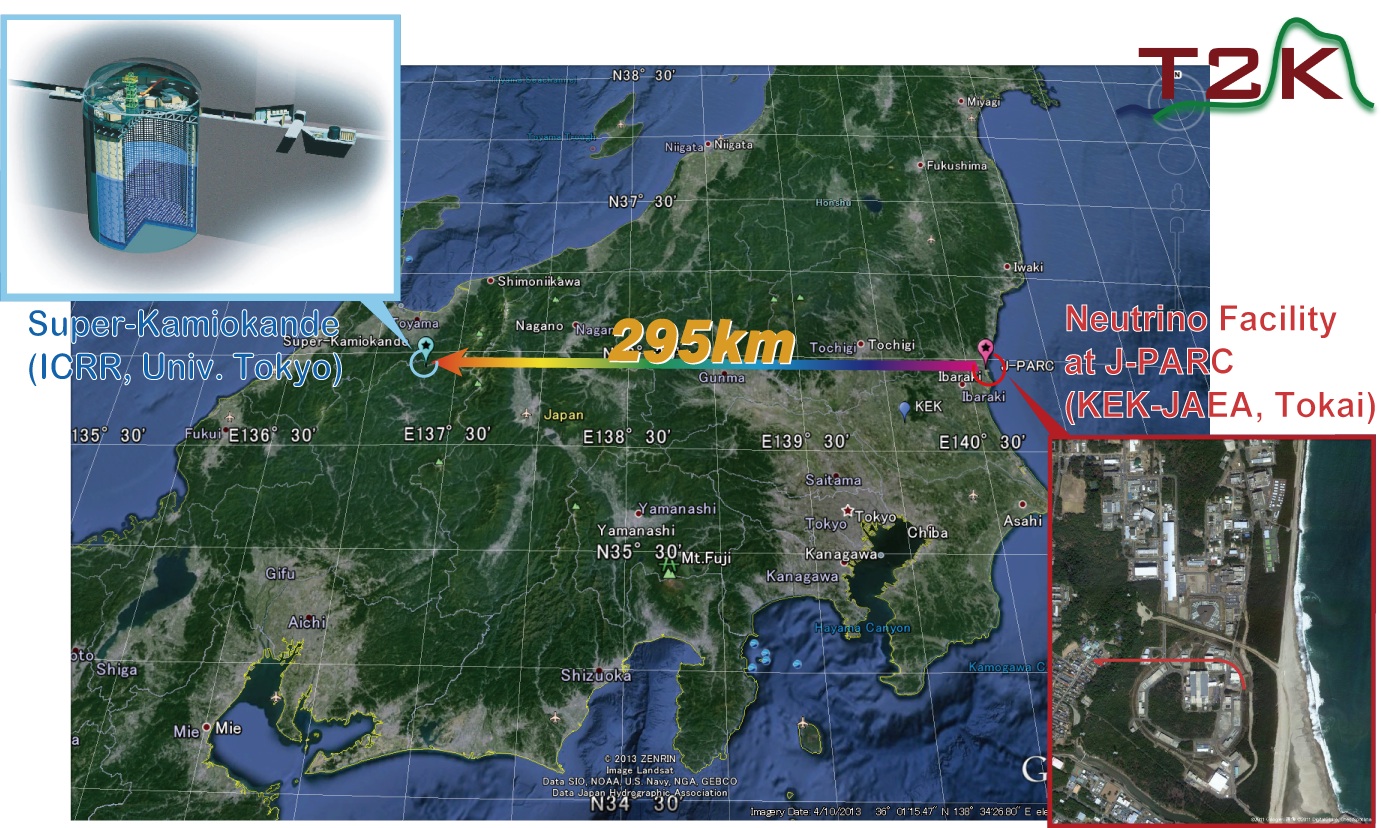 |
|
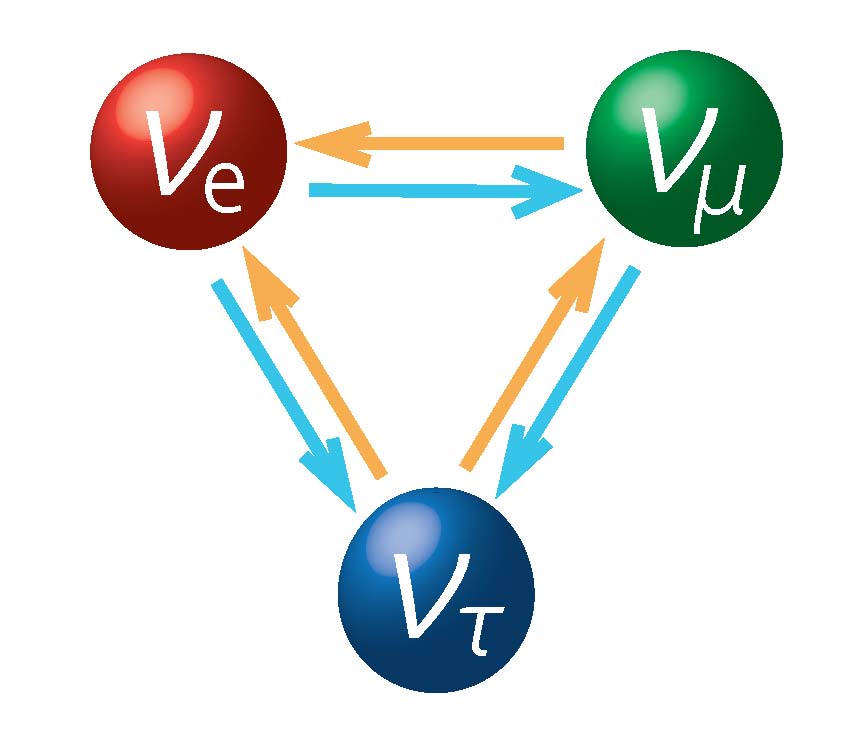 |
 |
|
Fig. 1: Overview of the T2K experiment |
|
In the T2K experiment in Japan, a muon neutrino beam is produced at the Japan Proton Accelerator Research Complex, called J-PARC, located in Tokai village, Ibaraki prefecture, on the east coast of Japan. The neutrino beam is monitored by a detector complex in Tokai and aimed at the gigantic Super-Kamiokande underground detector in Kamioka, near the west coast of Japan, 295 km (185 miles) away from Tokai. An analysis of the data from the Super-Kamiokande detector associated with the neutrino beam time from J-PARC reveals that there are more electron neutrinos (a total of 28 events) than would be expected (4.6 events) without this new process.
Neutrino oscillation is a manifestation of a long range quantum mechanical interference. Observation of this new type of neutrino oscillation leads the way to new studies of charge-parity (CP) violation, which provides a distinction in physical processes involving matter and antimatter. This phenomenon has only been observed in quarks (for which Nobel prizes were awarded in 1980 and 2008). CP violation in neutrinos in the very early universe may be the reason that the observable universe today is dominated by matter and no significant antimatter, which is one of the most profound mysteries in science. Now with T2K firmly establishing this form of neutrino oscillation that is sensitive to CP violation, a search for CP violation in neutrinos becomes a major scientific quest in the coming years, and T2K will continue to play a leading role. The T2K experiment expects to collect 10 times more data in the near future, including data with antineutrino beam for studies of CP violation in neutrinos.
The T2K experiment was constructed and is operated by an international collaboration. The current T2K collaboration consists of over 400 physicists from 59 institutions in 11 countries [Canada, France, Germany, Italy, Japan, Poland, Russia, Switzerland, Spain, UK and US]. The experiment is primarily supported by the Japanese Ministry of Education, Culture, Sports, Science and Technology (MEXT). Additional support is provided by the following funding agencies from participating countries: NSERC, NRC and CFI, Canada; CEA and CNRS/IN2P3, France; DFG, Germany; INFN, Italy; Ministry of Science and Higher Education, Poland; RAS, RFBR and the Ministry of Education and Science of the Russian Federation; MICINN and CPAN, Spain; SNSF and SER, Switzerland; STFC, U.K.; DOE, U.S.A.
The Kavli Institute for the Physics and Mathematics of the Universe (Kavli IPMU) recently joined the T2K collaboration in May of 2013, with a group consisting of individual members who have a long history of leadership on the experiment. Project Professor Mark Vagins has been a T2K collaborator since the experiment's inception, and is playing a major role in the operation of the Super-Kamiokande detector. Project Professor Chang Kee Jung has been the T2K US group spokesperson since 2004 and the International Co-spokesperson since 2011. Project Assistant Professor Mark Hartz has been a T2K collaborator since 2009 and joined the Kavli IPMU team in June of 2013. Prof. Mark Hartz has been a leader of the data analysis effort for the neutrino oscillation measurement described here. In addition to playing a central role in the coordination of analyses from all parts of the experiment, he has led the effort to simulate the production of neutrinos at the J-PARC facility and to measure the neutrino rate with the neutrino detectors located near the production point at J-PARC. Both of these efforts are essential to the observation of neutrino oscillations since it is necessary to know ahead of time how many neutrinos from oscillations or background sources should interact at Super-Kamiokande.
When asked to comment about the new T2K measurement, Prof. Hartz said, "This exciting measurement is an important step towards the goal of searching for CP violation in the oscillations of neutrinos. Now that muon neutrino to electron neutrino oscillations have been definitively detected, we have found an entirely new phenomenon through which we can look for differences in the behavior of matter and antimatter. I look forward to pursuing this research at the Kavli IPMU as a member of the T2K experiment and future neutrino oscillation experiments."
This discovery was made possible with the unyielding and tireless effort by the J-PARC staff members and the management to deliver high quality beam to T2K after the devastating March 2011 earthquake in eastern Japan, which caused severe damage to the accelerator complex at J-PARC, and abruptly discontinued the data-taking run of the T2K experiment.
More detailed information on this announcement including images, T2K experiment and T2K collaboration can be found from the T2K public webpage: http://t2k-experiment.org .
Contacts:
Kavli IPMU Public Relation Office
Yoshihisa Obayashi / Tomomi Hijikata
+81-4-7136-5974 / +81-4-7136-5977
press@ipmu.jp
Contacts for T2K experiment and related institutes are listed in the Press Release at KEK
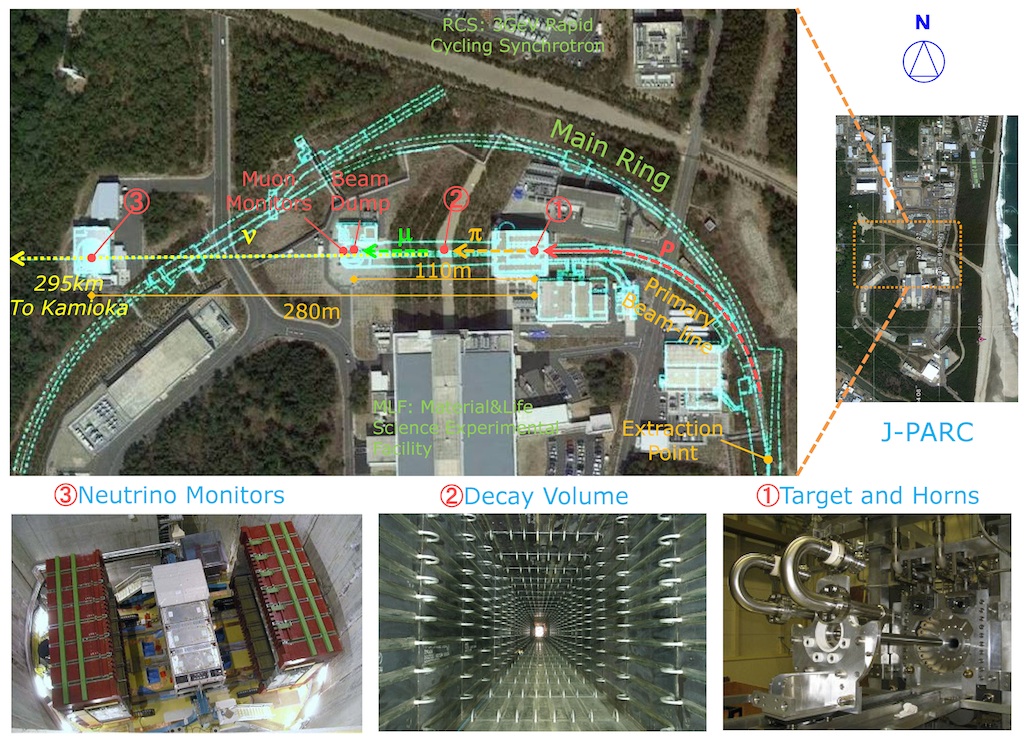 Fig. 2: J-PARC Neutrino Experiment Facility: The proton beam extracted from the J-PARC Main Ring synchrotron are directed westward through the T2K primary beam line. At the target station the protons strike a 1) target composed of graphite rods and produce numerous positively charged π-mesons which ar e in turn focused towards the forward direction under the effect magnetic horns. The π-mesons then decay into muon and muon neutrino pairs during flight in a 100-m-long tunnel, called 2)the decay volume. 3)Neutrino detectors located 280 m downstream of the target can monitor these muon neutrinos. A comparison of the measurements with those observed at Super-Kamiokande facilitates detailed studies of neutrino oscillation.
Fig. 2: J-PARC Neutrino Experiment Facility: The proton beam extracted from the J-PARC Main Ring synchrotron are directed westward through the T2K primary beam line. At the target station the protons strike a 1) target composed of graphite rods and produce numerous positively charged π-mesons which ar e in turn focused towards the forward direction under the effect magnetic horns. The π-mesons then decay into muon and muon neutrino pairs during flight in a 100-m-long tunnel, called 2)the decay volume. 3)Neutrino detectors located 280 m downstream of the target can monitor these muon neutrinos. A comparison of the measurements with those observed at Super-Kamiokande facilitates detailed studies of neutrino oscillation.
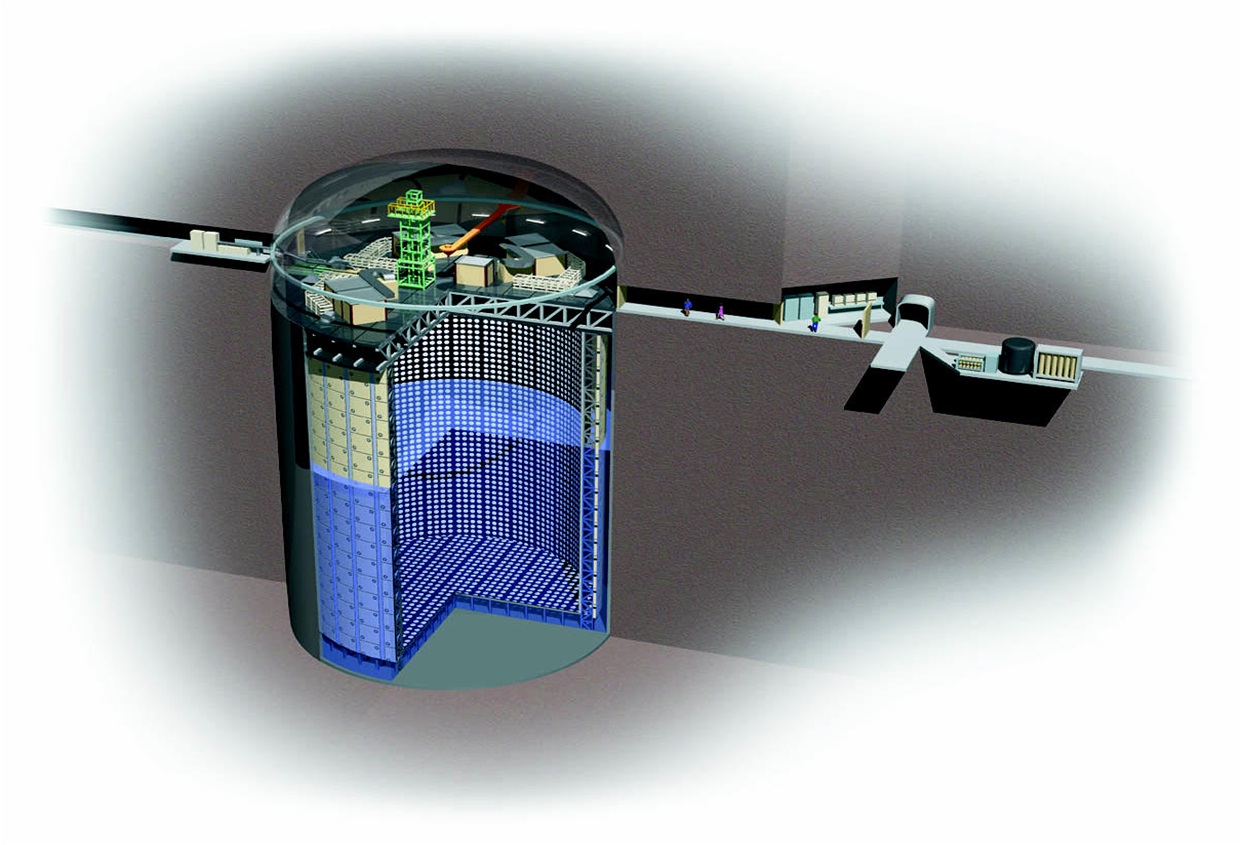 Fig. 3: Super-Kamiokande Detector: The world's largest underground neutrino detector affiliated with the Kamioka Observatory of the Institute for Cosmic Ray Research, the University of Tokyo. It is situated 1,000 m underground in the Kamioka Mine in Hida, Gifu Prefecture. Super-Kamiokande is observing neutrinos from outer space and conducting experiments and detects yet-to-be-discovered proton decays in addition to detecting neutrinos from J-PARC. This detector contains about 11,200 photomultiplier tubes, which are installed on the inside wall of a cylindrical water tank (39.3 m in diameter and 41.4 m in height) filled with 50,000 tons of water, to detect faint Cherenkov light emanating from charged particles traveling faster than the speed of light in water.
Fig. 3: Super-Kamiokande Detector: The world's largest underground neutrino detector affiliated with the Kamioka Observatory of the Institute for Cosmic Ray Research, the University of Tokyo. It is situated 1,000 m underground in the Kamioka Mine in Hida, Gifu Prefecture. Super-Kamiokande is observing neutrinos from outer space and conducting experiments and detects yet-to-be-discovered proton decays in addition to detecting neutrinos from J-PARC. This detector contains about 11,200 photomultiplier tubes, which are installed on the inside wall of a cylindrical water tank (39.3 m in diameter and 41.4 m in height) filled with 50,000 tons of water, to detect faint Cherenkov light emanating from charged particles traveling faster than the speed of light in water.
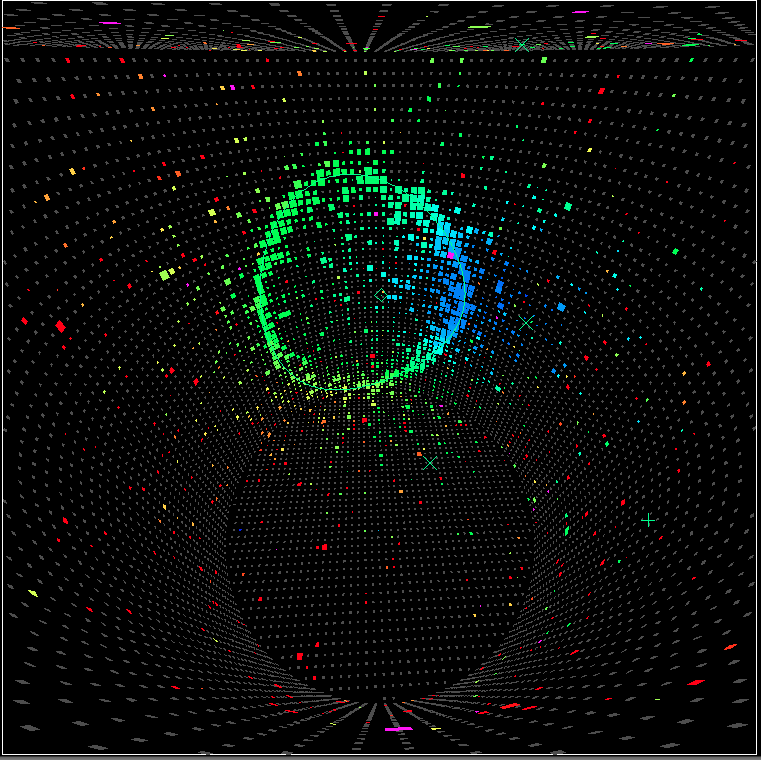 Fig. 4: An electron neutrino candidate event: In this 3D-image of cylinder-shaped Super-Kamiokande, each colored dot shows a photomultiplier tube that detected light. Electron neutrinos interact with water in the detector to produce electrons, which subsequently induce electromagnetic showers and eventually emit Cherenkov light, detected as a ring-shaped structure. This is the first candidate obtained after recovery from the 2011 great earthquake in the east coast of Japan.
Fig. 4: An electron neutrino candidate event: In this 3D-image of cylinder-shaped Super-Kamiokande, each colored dot shows a photomultiplier tube that detected light. Electron neutrinos interact with water in the detector to produce electrons, which subsequently induce electromagnetic showers and eventually emit Cherenkov light, detected as a ring-shaped structure. This is the first candidate obtained after recovery from the 2011 great earthquake in the east coast of Japan.
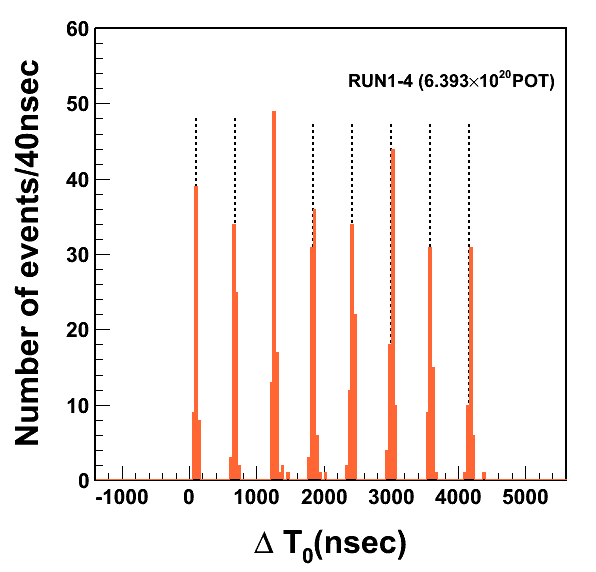 Fig. 5: Distribution of the T2K event timing observed at Super-Kamiokande: At J-PARC, neutrino beams are produced as pulses once in every 2.5 seconds. Each pulse has a fine-structure, with 8 “bunches”, originating from the scheme of acceleration of the proton beam. This figure shows the timing distribution of the events observed at Super-Kamiokande, where zero in the horizontal axis stands for the time when the forefront of each beam-shot arrives at Super-Kamiokande. We can clearly observe the beam-bunch structure.
Fig. 5: Distribution of the T2K event timing observed at Super-Kamiokande: At J-PARC, neutrino beams are produced as pulses once in every 2.5 seconds. Each pulse has a fine-structure, with 8 “bunches”, originating from the scheme of acceleration of the proton beam. This figure shows the timing distribution of the events observed at Super-Kamiokande, where zero in the horizontal axis stands for the time when the forefront of each beam-shot arrives at Super-Kamiokande. We can clearly observe the beam-bunch structure.
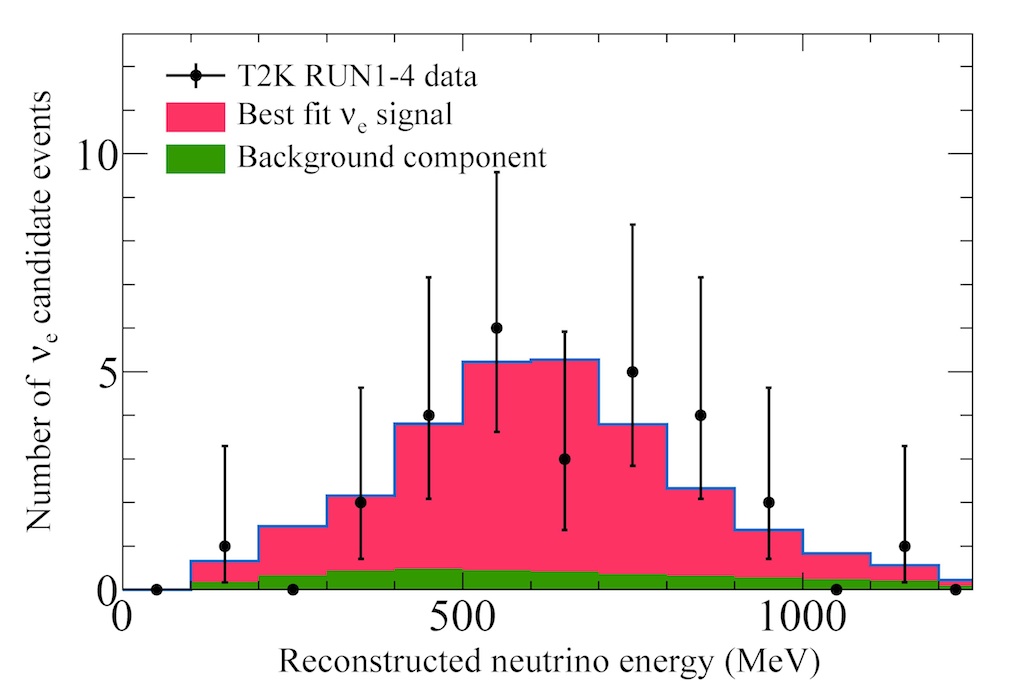 Fig. 6: Energy distribution of the electron neutrino appearance candidates : The data distribution (black dots with error bars) agrees well with the expectation, which consists of background events(green histogram)and electron neutrino appearance candidate events (red histogram).
Fig. 6: Energy distribution of the electron neutrino appearance candidates : The data distribution (black dots with error bars) agrees well with the expectation, which consists of background events(green histogram)and electron neutrino appearance candidate events (red histogram).






